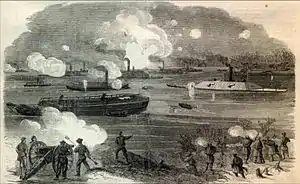CSS Fredericksburg
CSS Fredericksburg was an ironclad of the Confederate States Navy during the American Civil War, built at Richmond, Virginia in 1862-1863. Fredericksburg was the second ironclad to be completed in Richmond. On November 30, 1863 she was reported completed and awaiting armament. She was taken down to Drewry's Bluff in March 1864 for fitting out and was placed under the command of Commander Thomas R. Rootes, CSN.
 CSS Fredericksburg (far right) during the battle of Trent's Reach in 1865. | |
| History | |
|---|---|
| Name: | Fredericksburg |
| Operator: | Confederate States Navy |
| Laid down: | 1862 |
| Launched: | 1863 |
| Commissioned: | March 1864 |
| Fate: | Destroyed to prevent capture, 4 April 1865 |
| General characteristics | |
| Tons burthen: | 2,500 |
| Length: | 188 ft (57 m) |
| Beam: | 40 ft 3 in (12.27 m) |
| Draft: | 9 ft 6 in (2.90 m) |
| Propulsion: | Steam engine |
| Speed: | 5 knots (9.3 km/h) |
| Range: | 4,160 nmi (7,700 km) at 80 kn (150 km/h) |
| Complement: | 150 officers and men |
| Armament: |
|
| Service record | |
| Part of: | James River Squadron |
Fredericksburg, one of the ships of the James River Squadron commanded by Commodore John K. Mitchell, CSN, was actively engaged in the James River from mid-1864 until the end of the war. Accompanied by CSS Virginia II and nine other ships, Fredericksburg participated in an engagement at Trent's Reach with the Union's double-turreted monitor USS Onondaga on June 21, 1864; little damage was inflicted on either side due to the distance between the vessels.[1] Similar inconclusive encounters took place in August, October, December, and the following January. With the evacuation of Richmond on April 3, 1865, the Confederates blew up Fredericksburg and other warships in the vicinity the following day; the lost Confederate Fleet's remains were found in the James River. Fredericksburg's sunken hulk lies about 50 yards up river from the remains of her sister ironclad Virginia II; both lie parallel with the river under the heavy river silt and mud, somewhere between six and 15 feet deep.[2]
Notes
- "C.S.S. Fredericksburg".
- "Hunt for the Lost Confederate Fleet". Archived from the original on 2006-09-08. Retrieved 2006-09-26.
References
- Bisbee, Saxon T. (2018). Engines of Rebellion: Confederate Ironclads and Steam Engineering in the American Civil War. Tuscaloosa, Alabama: University of Alabama Press. ISBN 978-0-81731-986-1.
- Silverstone, Paul H. (2006). Civil War Navies 1855–1883. The U.S. Navy Warship Series. New York: Routledge. ISBN 0-415-97870-X.
- Still, William N. Jr. (1985). Iron Afloat: The Story of the Confederate Armorclads (Reprint of the 1971 ed.). Columbia, South Carolina: University of South Carolina Press. ISBN 0-87249-454-3.
- This article incorporates text from the public domain Dictionary of American Naval Fighting Ships. The entry can be found here.